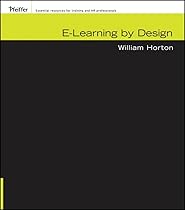The
University of Canberra Library has an excellent range of books on
e-learning. A recent one is:
Applied E-Learning and E-Teaching in Higher Education by Roisin Donnelly and Fiona McSweeney. This book is so new it has a copyright date of 2009. It includes material on
Blended E-Learning. There is a strong Australian flavour in the work. Here are some:
Page 32:
"... Australia: Australian National Training Authority. Garrett, B. (2003). School of Health and Social Care e-learning strategy. Retrieved November 9, 2004, from ..."
Page 40:
"... Staff de- velopers at Southern Cross University in Australia call their module a "staff immersion" programme that immerses participants in the role of online students, who learn about the ..."
Page 49:
"... Paper presented at the Annual Conference of the Australasian Society for Computers in Learning in Tertiary Education (ASCLITE), Melbourne, Australia. Retrieved July 4, 2007, from http:// www.ascllite.org.au/conferences/melbourne95/ smtu/papers/herrington.pdf Hinson, J., & LaPrairie, K. (2005). Learning to teach online: Promoting success ..."
Page 50:
"... American Association of Community Colleges. O'Reilly, M., & Brown, J. (2001). Staff develop- mentby immersion in interactive learning online. Lismore, Australia: Southern Cross University. Retrieved July 7, 2007, fromhttp://ausweb.scu.edu. au/aw0l /papers/refereed/o_reilly/paper. html Phipps, R. (2000). What's the difference? ..."
Page 52:
"... L. Rich- ardson & J. Lidstone (Eds.), Flexible learningfor a flexible society (pp. 372-378). Proceedings of ASET-HERDSA 2000 Conference, Toowoomba, Australia. Retrieved October 20, 2007, from http://www.ascilite.org.au/aset-archives/confs/ aset-herdsa2000/procs/kandlbinder2. ..."
Page 65:
"... throughout Ireland. Discussions with online guest tutors from the University of Tampere in Finland and the University of Queensland, Australia, took place during the module. ..."
Page 71:
"... Our guest tutors from Australia used this technology when they were interacting with our group. Our experience was that we felt we knew them much ..."
Page 75:
"... learn- ing changing? Paper presented at the Australian Society for Computers in Learning and in Ter- tiary Education Conference, Sydney, Australia. Retrieved August 8, 2007, from http://www. ascilite.org.au/conferences/sydney06/proceed- ing/pdf papers/p127.pdf Cowan, J. (1998). On becoming an innovative uni- versity teacher. ..."
Page 86:
"... are increasingly available for postgraduate supervision purposes. Supervision in this case refers to the guidance of research students in Ireland, Australia, the United King- dom, and other countries by academic mentors that are referred to as dissertation supervisors in Canadian and ..."
Page 89:
"... Two case studies are presented: one from the Dublin Institute of Technology, Ireland, and one from the University of Queensland, Australia. ..."
Page 98:
"... some useful websites? I've two questions I'd like to ask you. It would ap- pearfrom the volume of literature from Australia in the field of online learning that you guys are pretty much world leaders in this. Is that so? The ..."
Page 102:
"... Paper presented at the Third Australian World Wide Web Conference (AusWeb97), Australia. Anderson, N., & Henderson, M. (2004). E-PD: Blended models of sustaining teacher professional development in digital literacies. E-Learning, 1(3), 383-394. ..."
Page 103:
"... same stuff.- Student dissatisfaction with postgraduate courses. Paperpresented at the 15tAnnualHigher Education Research & Development Society of Australasia Conference, Sydney, Australia. Gibbs, G. (2004, June 21-23). The nature of educational development in a changing context. Keynote Presentation atthe International Consor- tium ..."
Product Description
Over the past decade, computer-enhanced learning has increased in demand due to developments in technological aids such as multimedia presentation and the internet. In this age of technology, it is imperative for teachers to consider the importance of technological integration in the classroom.
Applied E-Learning and E-Teaching in Higher Education presents international practices in the development and use of applied e-Learning and e-Teaching in the classroom in order to enhance student experience, add value to teaching practices, and illuminate best practices in the area of e-Assessment. This innovative title provides fresh insight into e-Learning and e-Teaching practices while exploring the varying roles of academic staff in adoption and application.
About the Author
Dr. Roisin Donnelly has over 15 years of experience in higher education both as a lecturer and researcher. She has taught in universities in Northern Ireland and was a lecturer and visiting research fellow in the University of New South Wales, Sydney. She is currently Programme Co-ordinator for DIT s MSc Applied eLearning, and tutors and supervises on the PG Certificate, Diploma and MA in Third Level Learning and Teaching. She has a range of chapter and journal publications to reflect her teaching and research interests, including academic development, designing eLearning, supporting virtual communities, tranformative pedagogies and blended problem-based learning.
Fiona McSweeney lectures in developmental psychology and research methods in the Department of Social Sciences of the Dublin Institute of Technology and in the psychology of learning and research methods with Waterford Institute of Technology. She has also worked as a learning development officer in the DIT. Her research interests focus on the student experience of higher education, assessment, the impact of professional education on identity, academic mentoring and the use of VLEs as a support for student learning and engagement in education. She is currently undertaking an Ed.D. with The Open University on student and professional identity and support.
Product Details
* Hardcover: 439 pages
* Publisher: Information Science Reference (August 1, 2008)
* Language: English
* ISBN-10: 1599048140
* ISBN-13: 978-1599048147 ...
From: Applied E-Learning and E-Teaching in Higher Education, Amazon.com description, 2008
Labels: blended learning, e-Learning, universities



 Greetings from the
Greetings from the 

